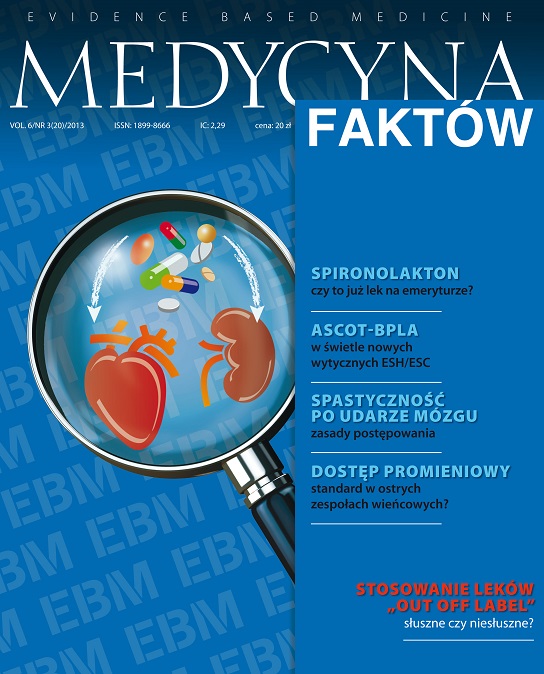Spastyczność po udarze mózgu Artykuł przeglądowy
##plugins.themes.bootstrap3.article.main##
Abstrakt
W pracy omówiono różne aspekty terapii spastyczności po udarze mózgu. Spastyczność poudarowa stanowi istotny problem kliniczny ze względu na możliwość znacznego ograniczenia czynności dnia codziennego i prawdopodobne przyczynianie się do powstawania powikłań. Podstawą efektywnego leczenia spastyczności poudarowej jest jej prawidłowa ocena i monitorowanie, przeważnie z użyciem skali MAS. Jedną z dostępnych opcji terapeutycznych spastyczności, zwłaszcza rozległej, jest podawanie tolperyzonu, leku zmniejszającego napięcie mięśniowe o wielopoziomowym działaniu. Omówione zostało podstawowe badanie kliniczne (Stamenowa 2005), w którym wykazano wysoką skuteczność i bezpieczeństwo terapii spastyczności poudarowej tolperyzonem.
##plugins.themes.bootstrap3.article.details##
Copyright © by Medical Education. All rights reserved.
Bibliografia
2. Watkins C.L., Leathley M.J., Gregson J.M., Moore A.P., Smith T.L., Sharma A.K.: Prevalence of spasticity post stroke. Clin. Rehabil. 2002; 16: 515-22.
3. O’Brien C.F., Seeberger L.C., Smith D.B.: Spasticity after stroke. Epidemiology and optimal treatment. Drugs Aging 1996; 9(5): 332-40.
4. Lance J.W.: What is spasticity? Lancet 1990; 335: 606.
5. Cooper A., Musa I.M., van Deursen R., Wiles C.M.: Electromyography characterization of stretch responses in hemiparetic stroke patients and their relationship with the Modified Ashworth scale. Clin. Rehabil. 2005; 19: 760-6.
6. Kim D.Y., Park C.I., Chon J.S., Ohn S.H., Park T.H., Bang I.K.: Biomechanical assessment with electromyography of post-stroke ankle plantar flexor spasticity. Yonsei Med. J. 2005; 46: 546-54.
7. Welmer A.K., von Arbin M., Widen Holmqvist L., Sommerfeld D.K.: Spasticity and its association with functioning and health-related quality of life 18 months after stroke. Cerebrovasc. Dis. 2006; 21: 247-53.
8. Thompson F.J., Parmer R., Reier P.J., Wang D.C., Bose P.: Scientific basis of spasticity: insights from a laboratory model. J. Child. Neurol. 2001; 16: 2-9.
9. Mayer N.H.: Clinicophysiologic concepts of spasticity and motor dysfunction in adults with an upper motoneuron lesion. Muscle Nerve Suppl. 1997; 6: S1-13.
10. Pierson S.H.: Outcome measures in spasticity management. Muscle Nerve Suppl. 1997; 6: S36-60.
11. Hsieh Y.W., Hsueh I.P., Chou Y.T., Sheu C.F., Hsieh C.L., Kwakkel G.: Development and validation of a short form of the Fugl-Meyer motor scale in patients with stroke. Stroke 2007; 38: 3052-4.
12. van der Salm A., Veltink P.H., Hermens H.J., Ijzerman M.J., Nene A.V.: Development of a new method for objective assessment of spasticity using full range passive movements. Arch. Phys. Med. Rehabil. 2005; 86: 1991-7.
13. Lockley L.: The role of the specialist physiotherapist in the management of spasticity. Way Ahead 2004; 7: 6-7.
14. Katz R.T., Rovai G.P., Brait C. et al.: Objective quantification of spastic hypertonia: correlation with clinical findings. Arch. Phys. Med. Rehabil. 1992; 73(4): 339-47.
15. Goldstein E.M.: Spasticity management: an overview. J. Child. Neurol. 2001; 16: 16-23.
16. Tilton A.H.: Injectable neuromuscular blockade in the treatment of spasticity and movement disorders. J. Child. Neurol. 2003; 18(Suppl. 1): S50-66.
17. Van Kuijk A.A., Geurts A.C.H., Bevaart B.J.W., van Limbeek J.: Treatment of upper extremity spasticity in stroke patients by focal neuronal or neuromuscular blockade: a systematic review of the literature. J. Rehab. Med. 2002; 34: 51.
18. Mc Guire J.R.: Effective use of chemodenervation and chemical neurolysis in the management of poststroke spasticity. Top. Stroke Rehabil. 2001; 8: 47.
19. Gracies J.M., Nance P., Elovic E. et al.: Traditional pharmacological treatments for spasticity. Part II: General and regional treatments. Muscle Nerve Suppl. 1997; 6: S92-120.
20. Gracies J.M., Elovic E., McGuire J. et al.: Traditional pharmacological treatments for spasticity. Part I: Local treatments. Muscle Nerve Suppl. 1997; 6: S61-91.
21. Pratzel H.G., Alken R.G., Ramm S.: Efficacy and tolerance of repeated oral doses of tolperisone hydrochloride in the treatment of painful reflex muscle spasm: results of a prospective placebo-controlled double-blind trial. Pain 1996; 67(2-3): 417-25.
22. Stamenova P., Koytchev R., Kuhn K. et al.: A randomized, double-blind, placebo-controlled study of the efficacy and safety of tolperisone in spasticity following cerebral stroke. Eur. J. Neurol. 2005; 12(6): 453-61.
